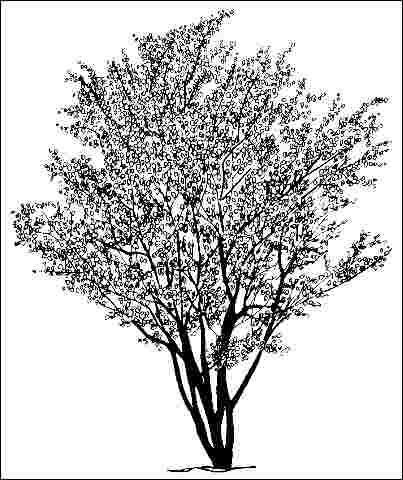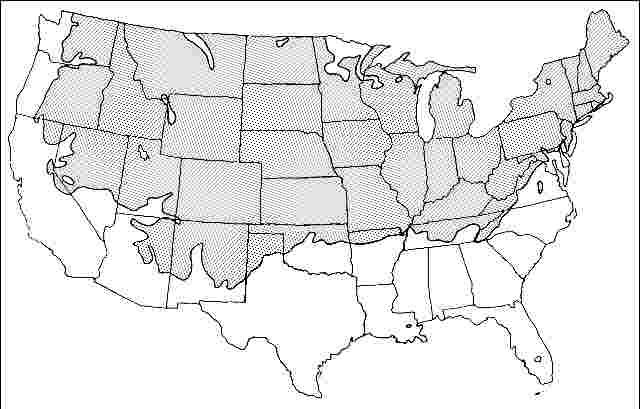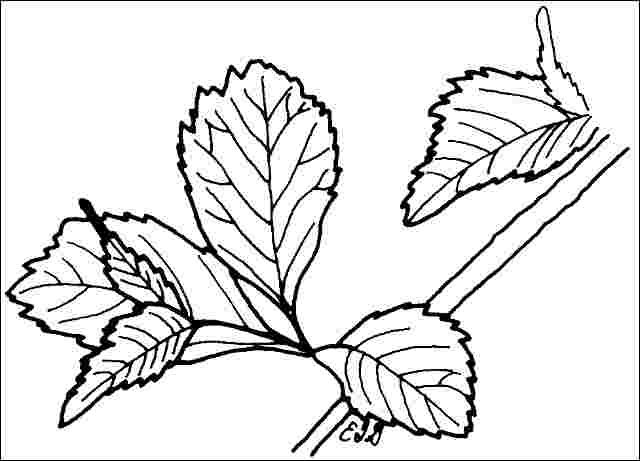Introduction
Reaching a height of 12 feet with an equal spread, Flowering-Almond has beautiful, double pink flowers which appear in midspring. It provides a wonderful accent in a residential yard or courtyard when in flower. Be sure to locate it in a groundcover or mulched bed, as mechanical injury or stress of any kind hasten the demise of this short-lived tree. It is also very suitable in a shrub border as a tall accent. It can be sculptured nicely into a unique form with proper pruning and training and is well suited for container gardening. Regular pruning is needed for best flowering performance. Branches cut in early spring can be forced into bloom indoors.

General Information
Scientific name: Prunus triloba var. multiplex
Pronunciation: PROO-nus try-LOW-buh variety MULL-tih-plecks
Common name(s): Flowering-Almond, Double-Flowering Plum
Family: Rosaceae
USDA hardiness zones: 3B through 6B (Fig. 2)
Origin: not native to North America
Invasive potential: little invasive potential
Uses: container or planter; trained as a standard; deck or patio; specimen; Bonsai; highway median
Availability: not native to North America

Description
Height: 10 to 15 feet
Spread: 10 to 15 feet
Crown uniformity: symmetrical
Crown shape: vase, round
Crown density: moderate
Growth rate: moderate
Texture: medium
Foliage
Leaf arrangement: alternate (Fig. 3)
Leaf type: simple
Leaf margin: double serrate, serrate, dentate
Leaf shape: elliptic (oval), obovate
Leaf venation: pinnate, reticulate
Leaf type and persistence: deciduous
Leaf blade length: less than 2 inches, 2 to 4 inches
Leaf color: green
Fall color: yellow, copper
Fall characteristic: showy

Flower
Flower color: pink
Flower characteristics: very showy
Fruit
Fruit shape: round
Fruit length: .5 to 1 inch
Fruit covering: fleshy
Fruit color: red
Fruit characteristics: attracts squirrels/mammals; not showy; fruit/leaves not a litter problem
Trunk and Branches
Trunk/bark/branches: branches droop; not showy; typically multi-trunked; thorns
Pruning requirement: little required
Breakage: resistant
Current year twig color: brown
Current year twig thickness: thin
Wood specific gravity: unknown
Culture
Light requirement: full sun, partial sun or partial shade
Soil tolerances: clay; sand; loam; acidic; well-drained
Drought tolerance: moderate
Aerosol salt tolerance: none
Other
Roots: not a problem
Winter interest: no
Outstanding tree: yes
Ozone sensitivity: sensitive
Verticillium wilt susceptibility: susceptible
Pest resistance: sensitive to pests/diseases
Use and Management
Flowering-Almond grows best in sun or partial shade on rich, moist soil. Keep turf grass cleared away from a four to six-foot diameter circle around the tree. It transplants well and grows at a moderate pace.
`Plena' has double flowers; var. simplex has single flowers sometimes followed by red fruit.
Pests
Aphids cause distortion of new growth, deposits of honeydew, and sooty mold.
Borers attack trees under stress. Keep trees healthy with regular fertilizer applications and irrigation in drought.
Scales of several types infest Prunus spp. Horticultural oil can be used to help control overwintering stages.
Spider mites cause yellowing or stippling but are very difficult to see. They are usually recognized only after plant symptoms are quite advanced.
Tent caterpillars make large webbed nests in trees then eat the foliage. One defoliation may not be serious and small nests can be pruned out and destroyed. Use Bacillus thuringiensis when the insects are first seen and are still small.
Diseases
A bacterium causes leaf spot and twig cankers on cherry. Small, reddish spots dry, and drop out, giving a shot holed appearance. Defoliation can be severe when conditions favor disease development. Fertilize infected trees and prune out infected branches.
A fungus causes reddish spots which drop out leaving shot holes. Once the hole appear the leaves may drop. The disease is worse in wet weather.
Black knot causes black swellings or galls on the branches. Branches with galls are pruned out.
Powdery mildew causes a white coating on the leaves.